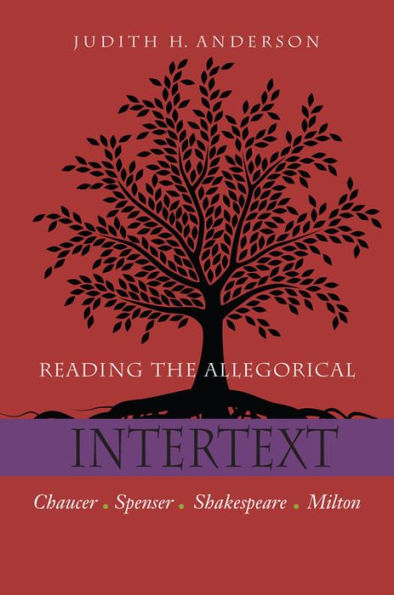5
1

Reading the Allegorical Intertext: Chaucer, Spenser, Shakespeare, Milton
452
by Judith H. Anderson
Judith H. Anderson

Reading the Allegorical Intertext: Chaucer, Spenser, Shakespeare, Milton
452
by Judith H. Anderson
Judith H. Anderson
Paperback(3)
$40.00
-
PICK UP IN STORECheck Availability at Nearby Stores
Available within 2 business hours
Related collections and offers
40.0
In Stock
Overview
Judith H. Anderson conceives the intertext as a relation between or among texts that encompasses both Kristevan intertextuality and traditional relationships of influence, imitation, allusion, and citation. Like the Internet, the intertext is a state, or place, of potential expressed in ways ranging from deliberate emulation to linguistic free play. Relatedly, the intertext is also a convenient fiction that enables examination of individual agency and sociocultural determinism. Anderson's intertext is allegorical because Spenser's Faerie Queene is pivotal to her study and because allegory, understood as continued or moving metaphor, encapsulates, even as it magnifies, the process of signification. Her title signals the variousness of an intertext extending from Chaucer through Shakespeare to Milton and the breadth of allegory itself. Literary allegory, in Anderson's view, is at once a mimetic form and a psychic one-a process thinking that combines mind with matter, emblem with narrative, abstraction with history. Anderson's first section focuses on relations between Chaucer's Canterbury Tales and Spenser's The Faerie Queene, including the role of the narrator, the nature of the textual source, the dynamics of influence, and the bearing of allegorical narrative on lyric vision. The second centers on agency and cultural influence in a variety of Spenserian and medieval texts. Allegorical form, a recurrent concern throughout, becomes the pressing issue of section three. This section treats plays and poems of Shakespeare and Milton and includes two intertextually relevant essays on Spenser.How Paradise Lost or Shakespeare's plays participate in allegorical form is controversial. Spenser's experiments with allegory revise its form, and this intervention is largely what Shakespeare and Milton find in his poetry and develop. Anderson's book, the result of decades of teaching and writing about allegory, especially Spenserian allegory, will reorient thinking about fundamental critical issues and the landmark texts in which they play themselves out.

Product Details
| ISBN-13: | 9780823228485 |
|---|---|
| Publisher: | Fordham University Press |
| Publication date: | 01/03/2011 |
| Edition description: | 3 |
| Pages: | 452 |
| Product dimensions: | 5.60(w) x 8.60(h) x 1.20(d) |
About the Author
Judith H. Anderson is Chancellor's Professor of English at Indiana University.
Table of Contents
Prior Publication ix
Introduction: Reading the Allegorical Intertext 1
Allegorical Reflections of The Canterbury Tales in The Faerie Queene
Chaucer's and Spenser's Reflexive Narrators 27
What Comes after Chaucer's But in The Faerie Queene 42
"Pricking on the plaine": Spenser's Intertextual Beginnings and Endings 54
Allegory, Irony, Despair: Chaucer's Pardoner's and Franklin's Tales and Spenser's Faerie Queene, Books I and III 61
Eumnestes' "immortall scrine": Spenser's Archive 79
Spenser's Use of Chaucer's Melibee: Allegory, Narrative, History 91
Agency, Allegory, and History within the Spenserian Intertext
Spenser's Muiopotmos and Chaucer's Nun's Priest's Tale 109
Arthur and Argante: Parodying the Ideal Vision 126
Chaucer's Parliament of Fowls and Refractions of a Veiled Venus in The Faerie Queene 135
The Antiquities of Fairyland and Ireland 154
Better a mischief than an inconvenience: "The saiying self" in Spenser's View of the Present State of Ireland 168
Spenserian Allegory in the Intertexts of Shakespeare and Milton
The Conspiracy of Realism: Impasse and Vision in The Faerie Queene and Shakespeare's King Lear 183
Venus and Adonis: Spenser, Shakespeare, and the Forms of Desire 201
Flowers and Boars:Surmounting Sexual Binarism in Spenser's Garden of Adonis 214
Androcentrism and Acrasian Fantasies in the Bower of Bliss 224
Beyond Binarism: Eros/Death and Venus/Mars in Antony and Cleopatra and The Faerie Queene 239
Patience and Passion in Shakespeare and Milton 259
"Real or Allegoric" in Herbert and Milton: Thinking through Difference 272
Spenser and Milton: The Mind's Allegorical Place 280
Notes 321
Index 423
From the B&N Reads Blog
Page 1 of
